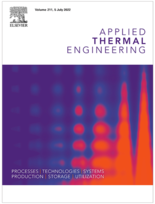
Thermal performance of a solar-assisted slinky foundation heat exchanger coupled with a heat pump in a cold climate.
Author(s) : DAVANI S., DARBANDI A., GRUENES J., HOXIE A., MWESIGYE A.
Type of article: Periodical article
Summary
Using the excavation of a building’s foundation offers a cost-effective solution to alleviate the high installation costs hindering the widespread adoption of ground-source heat pump systems. However, limited land space in urban areas and higher heating loads in cold climates pose challenges. Issues like ground thermal imbalances and prolonged freezing around the heat exchanger can impair performance. To address these, a novel solar-assisted ground source heat pump with a slinky foundation ground heat exchanger and a solar-heated recovery heat exchanger loop embedded in the building’s foundation is proposed. A 3D transient finite element numerical model is developed to evaluate the performance of the proposed system. Realistic building energy loads obtained from a building energy simulation with time-varying ambient temperature and solar irradiation are coupled to the foundation heat exchanger to predict the long-term transient performance of the system. Results show that implementing a solar-assisted foundation heat exchanger system reduces soil freezing from 58.3 % to 32.4 % of the year, and heat pump shut-off occurrences caused by low entering fluid temperature drop from 38.9 % to 5.8 %. Additionally, incorporating an auxiliary heater eliminates heat pump shut-offs and reduces the soil freezing period to 6.3 %. Moreover, extending the heat exchangers beyond the footprint of the house mitigates the soil freezing problem completely and reduces the demand for auxiliary heating.
Available documents
Format Website
Available
Free
Details
- Original title: Thermal performance of a solar-assisted slinky foundation heat exchanger coupled with a heat pump in a cold climate.
- Record ID : 30033578
- Languages: English
- Source: Applied Thermal Engineering - vol. 261
- Publication date: 2025/02/15
- DOI: http://dx.doi.org/10.1016/j.applthermaleng.2024.124986
Links
See the source
-
Size and match of the collector-evaporator for ...
- Author(s) : MA J., ZHU X., FAN H., SU J., LU Y., ZHANG Z.
- Date : 2025/03
- Languages : English
- Source: International Journal of Refrigeration - Revue Internationale du Froid - vol. 171
- Formats : PDF
View record
-
A thermoeconomic model of a photovoltaic heat p...
- Author(s) : MASTRULLO R., RENNO C.
- Date : 2010/10
- Languages : English
- Source: Applied Thermal Engineering - vol. 30 - n. 14-15
View record
-
Heat dissipation effect on a borehole heat exch...
- Author(s) : DARKWA J., SU W., CHOW D. H. C.
- Date : 2013/10
- Languages : English
- Source: Applied Thermal Engineering - vol. 60 - n. 1-2
View record
-
Wspolczesne rozwiazania konstrukcyjne pionowych...
- Author(s) : WAJMAN M.
- Date : 2012/02
- Languages : Polish
- Source: Technika Chlodnicza i Klimatyzacyjna - vol. 19 - n. 2
- Formats : PDF
View record
-
Dynamic modeling study for a solar evaporator w...
- Author(s) : FARIA R. N., NUNES R. O., KOURY R. N. N., et al.
- Date : 2016/04
- Languages : English
- Source: International Journal of Refrigeration - Revue Internationale du Froid - vol. 64
- Formats : PDF
View record
